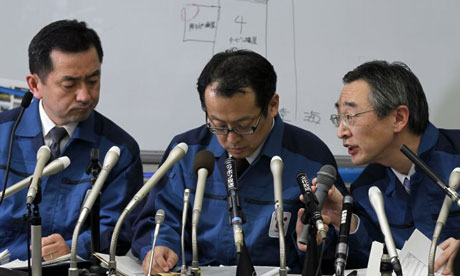
CRISIS NON STOP....
Workers battling to prevent nuclear meltdown at the stricken Fukushima Daiichi plant were temporarily evacuated on Wednesday morning after radiation levels became too dangerous for them to remain.
The withdrawal hampered efforts to secure safety at the atomic power plant and avert a major radiation leak. Staff returned to the plant after about an hour once radiation levels fell.
Its operator, Tokyo Electric Power (Tepco) said it was considering using helicopters to spray the crippled No 4 reactor with water and boric acid – a fire retardant – in an attempt to prevent more radiation leaks.
The 50 or so engineers, working around the clock in harsh conditions, spent Wednesday morning trying to put out a fire at one reactor and to cool others at risk of overheating and reaching criticality.
To compound problems, a fire broke out at the No 3 reactor, where a fuel storage pool had overheated and may have let off radioactive steam. Live TV footage showed a large cloud of light grey smoke rising above the plant.
The government's chief spokesman, Yukio Edano, said Japan was considering seeking help from the US military.
All six of the plants reactors are experiencing problems following last Friday's earthquake and tsunami, in which an estimated 10,000 people have died.
The workers were ordered to leave the facility after the level of radiation at the plant soared to 10 millisieverts per hour – above the level considered harmful to human health – possibly as a result of radioactive substances being emitted from the No 2 reactor. The reading later fell to around six millisieverts per hour, reports said, and they were allowed to return.
The evacuation followed another day of crisis at the plant, which has become the focus of the world's attention, even as rescue workers sift through the damage caused by the tsunami along a vast stretch of Japan's north-east coast.
Earlier, officials from the nuclear and industrial safety agency said that 70% of fuel rods at the No 1 reactor had been significantly damaged, as well as 33% of rods at the No 2 reactor. The cores of both reactors are believed to have partially melted, Kyodo news agency said.
"We don't know the nature of the damage," said Minoru Ohgoda, spokesman for the country's nuclear safety agency. "It could be either melting, or there might be some holes in them."
Before they were moved to safety the workers had been trying to cool spent nuclear fuel pools at the No 5 and No 6 reactors, where temperatures have risen above normal levels.
Edano said that there was "a possibility that the No 3 reactor's containment vessel is damaged".
A blaze also broke out again at the No 4 reactor, which was already feared to be at risk of leaking radioactivity. The nuclear safety agency reported that flames and smoke were no longer visible half an hour later, but were unable to confirm that the fire had been extinguished.
The No 4 reactor is an increasing cause for concern. Tepco believes that the storage pool may be boiling, raising the possibility that exposed rods will reach criticality. "The possibility of re-criticality is not zero," a Tepco spokesman said.
The government has ordered 140,000 people living within a 19-mile radius of the plant to remain indoors after a spike in radiation levels. A further 70,000 residents had already been moved to safe distances. The government said it had no immediate plans to widen the evacuation zone.
The crisis unfolding in Fukushima continued to raise anxiety levels in Tokyo, 150 miles to the south. Radiation levels in the capital were 10 times higher than normal on Tuesday evening, but posed no health hazard, the government said.
The meteorological agency said winds near the power plant would blow from the north-west and out into the Pacific Ocean on Wednesday. The winds were expected to strengthen in the afternoon, the agency added.

No comments:
Post a Comment